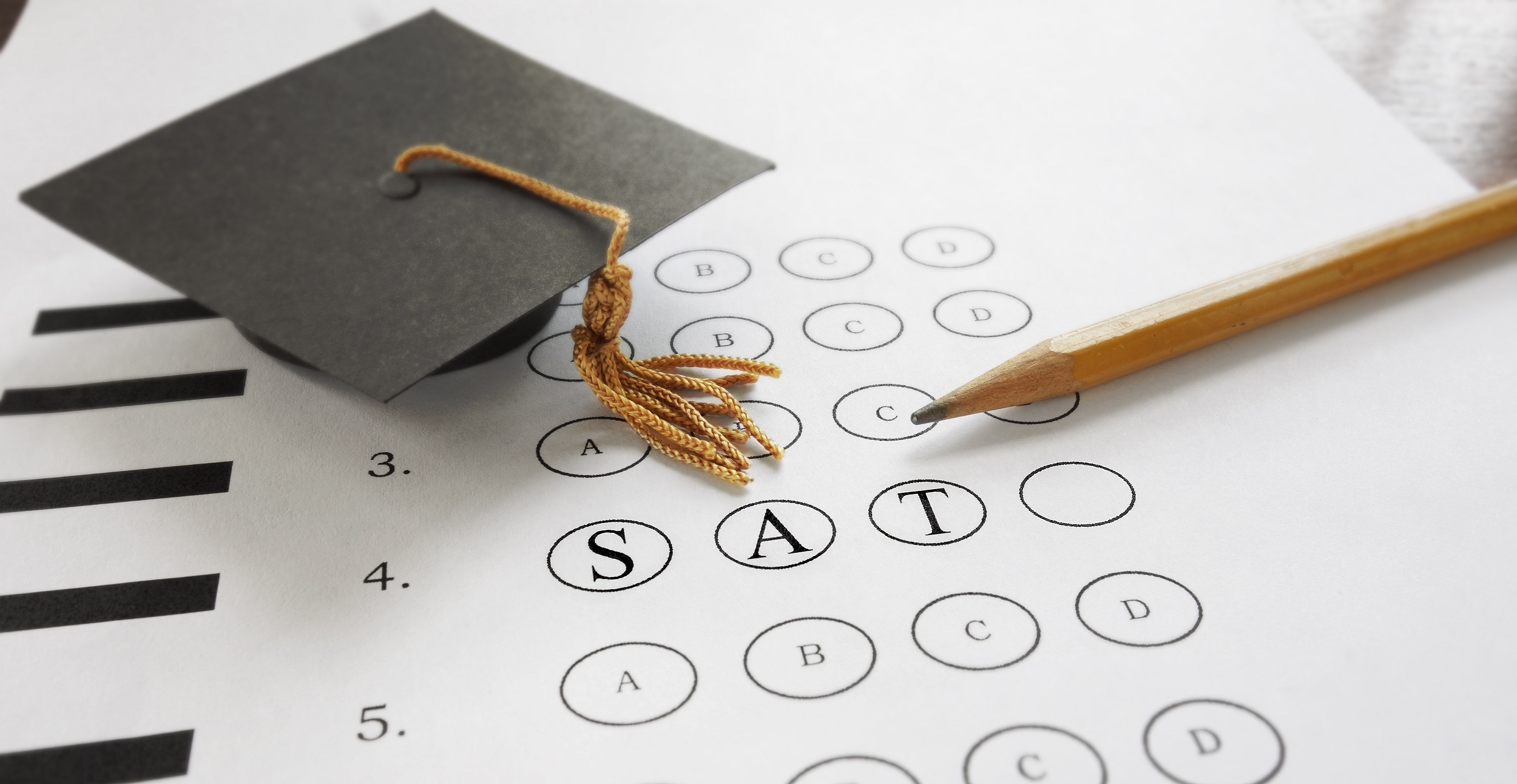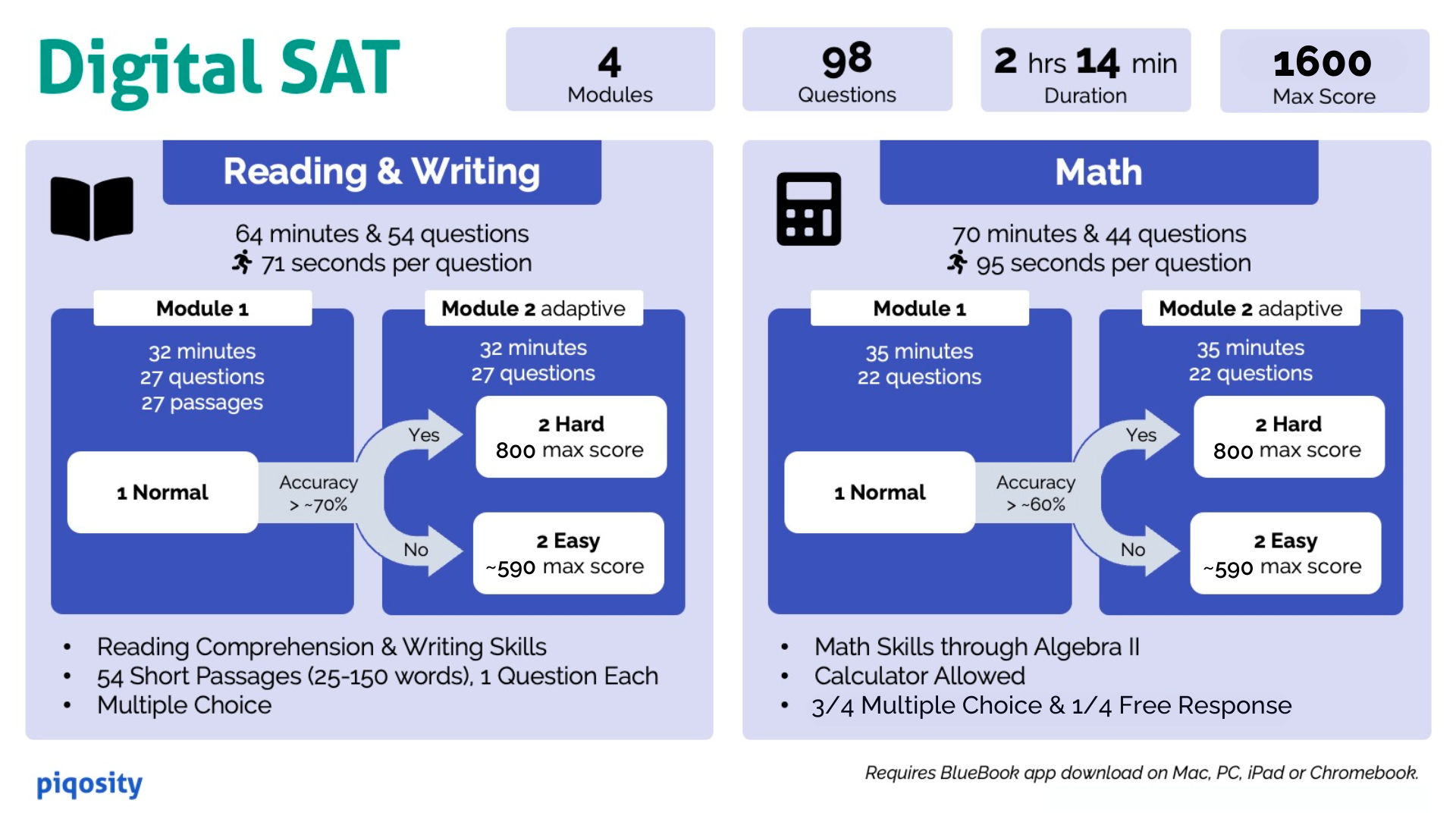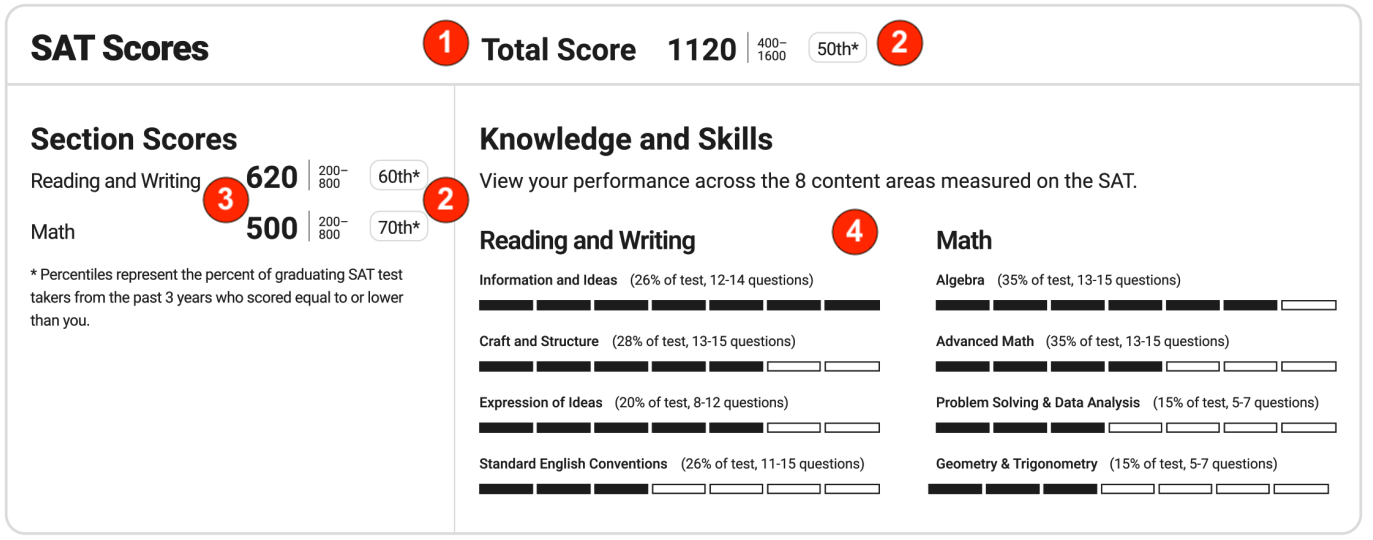
If you’re a high school junior, you probably know that a good score on the digital SAT can make your college application stand out—but what is a good score on the SAT? This article aims to answer this question by showing how you can adequately gauge what is the best SAT score for you, plus advice for the preparation necessary for you to achieve that goal. Read on for a roadmap to personal SAT success!
What is the SAT, and Why Take It?
The SAT is a standardized college admissions test that high schoolers take prior to applying for college; it helps colleges see exactly where potential students rank academically and cognitively. Some states and schools require students to take the SAT to graduate.
The SAT is administered in a digital format, made up of two equal-length sections: Reading & Writing and Math. All questions are multiple choice, and there is no penalty for guessing incorrect answers when taking the SAT.

The SAT gives colleges an easy-to-compare set of data about potential candidates, which in turn suggests how they may fit into the school and their particular class. Note that every college takes a different approach to the SAT:
- Some colleges require the SAT.
- Most schools are test-optional. They do not require the SAT, but will still accept scores and take them into account when making admissions decisions.
- Test-blind schools will not look at scores, even if you send them in.
For students, SAT offers an opportunity to show choice colleges exactly what you can do. It also gives you a chance to demonstrate your academic prowess compared to the other students in your class nationwide. Even if the schools you apply to do not require a college entrance exam, good SAT scores will help you stand out above the fray. Additionally, taking the SAT also opens the doors for potentially thousands of dollars in academic scholarships.
Wondering whether you should take the ACT instead?
As the second-most popular college admissions exam, the ACT is considerably different from the digital SAT. If neither your state nor your choice college requires the SAT, look into the differences between the ACT and SAT to see which test is the right fit for you.
Should You Aim for a Certain SAT Score?
Before going further into what is a good score on the SAT, an important point to consider is: should you try to get a certain SAT score? Or, should you just take it and hope your score will get you into a good college?
The short answer is: Yes, you should have a specific goal in mind.
Some high school students take the SAT only because their state or school requires them to do so, because all of their friends are taking it too, or because their parents are encouraging (or pressuring) them to do it. These students may think of taking the SAT as a box to be checked, and walk in on test day hoping for the best. They take the SAT without a goal, and without understanding exactly what a great score may mean for them.
If they prepare for the SAT beforehand, they do so without a strategy. They might glance at some study materials, but not in a focused or directed way. These students take the test, receive their scores, and then wonder if they did alright. They may not get into their favorite college, or they’ll lose out on scholarship money, all because they didn’t have a goal or a plan to meet it.
To get a good SAT Score, you need a goal to aim for. Choose a few colleges you are interested in, and look up their test requirements. If a school is test-optional or requires the SAT, check which scores they accepted in the last year. Use this to pick a goal, and aim for this goal to determine your digital SAT test prep strategy. Then, instead of going into the test without expectations and wondering about your SAT score afterward, you will know exactly how you did in relation to your goal, and you can better plan your next steps. We’ll talk about this more later in this article.
If you have already taken the SAT, and did so without setting a goal first, never fear. You can still retroactively do the kind of research described above. If you received a score less than what you wanted, read on to find out how Piqosity can help you achieve your goals with a retake.
How is the SAT Scored?
To understand exactly what is a good score on the SAT, you need to understand how it is scored. Even though the SAT exam was redesigned, the scoring system remains the same: the sum of your Reading and Writing section score and Math section score is your total score.
Let’s contextualize this scoring by explaining some of the figures on the basic score report you’ll receive after taking the digital SAT, which will look something like this:

SAT Score Reports can be confusing, since they present a lot of data, though the main page of the report has been simplified from that of the old SAT. We’ll go through the most important points below. Each numbered explanation corresponds with the circled red number in the image above.
- Total SAT Score. Your total SAT score may fall anywhere between 400 and 1600—it is calculated by adding the scores (between 200 and 800 points each) you receive for the Reading and Writing section and the Math section.
- Percentile Ranks. Your score report also provides your percentile rankings (between 1 and 99) for your total score, as well as for your Math/Reading and Writing test scores. Percentile ranks tell colleges how you scored in relation to other students. More specifically, the percentiles on digital SAT Score Reports represent test-takers from the past three years. (So, the example student in this score report performed better than half of SAT testers from the last 3 years.)
- Section Scores. Your section scores are simply the points you earned on each section of the SAT. As we mentioned above, each score is also accompanied by a percentile rank.
- Content Area Performance. This digital SAT Score Report makes it easier than ever before to evaluate your test performance, down to how you did on specific subject areas. The Knowledge and Skills graphic breaks down the eight content areas measured across the digital SAT, demonstrating your accuracy in each content area. When you’re studying for an SAT retake after you get your score report, make sure to reference this section for the topics you should focus on the most!
Now that you know how to read it, you can use your SAT score report as a tool to figure out where to focus your further test preparation. Or, compare it to your colleges’ requirements and decide which colleges to apply to and which may be unrealistic.
This should also help you make sense of un-nuanced questions like “Is 1200 a good SAT score?” (it depends) or even, “Is 700 a good SAT score?” (if you’re referring to a Section Score, yes; if you’re referring to a Total Score, no).
What is the best SAT score possible?
The highest SAT Total Score possible is a 1600, indicating a 99th percentile rank or higher. The lowest possible Composite Score is a 400, indicating a 1st percentile rank or lower. As with most standardized tests, most students score somewhere in the middle, so this is where most competition lies within percentile rankings.
So…What SAT Score Should You Aim For?
As you’ve gathered by now, this is a loaded question, and the answer is going to be different for everyone. You will need to take into account both your post-secondary educational goals and the performance of your peers, which changes yearly. For instance, if your goal is to score “above average” in 2024, you will want to aim higher than the average 2023 score, which was a 1020.
Of course, if you want to attend a very prestigious school, you will have to aim even higher than just “above average.”
What is a Good SAT Score for College Admissions?
The answer to this question depends a lot on which college(s) you are hoping to attend. In general, a good rule of thumb is to aim for a score that is higher than the average score of the previous year’s admitted students (this data is readily available online).
Since so many people ask about it, let’s look briefly at the scores you might want to aim for for Ivy League admissions. Even for those that are now test-optional, submitting a good score can help you stand out above the rest.
- To be accepted into Harvard, you will want to aim above the average score of the other students who have recently been accepted. This means you will at least want an SAT score above 1520. Harvard requires applicants to submit their test scores.
- Similarly, if you’re hoping to attend Yale, a good goal would be to score higher than their current average score of 1515. Yale currently has a test-flexible policy in which first-year applicants must submit a test score, but they may choose between using ACT, SAT, IB, or AP scores.
- Princeton is currently test-optional until Fall 2026 (at which point it will require test scores), but submitting test scores will make your application more competitive. The SAT score to aim for here is above 1540.
As you can see, the scores for these prestigious colleges are well above the national average. If your scores are significantly below these marks, especially after an SAT retake, you may want to reconsider whether you are a good fit for these institutions. That said, it never hurts to apply, and remember: these schools also look at other parts of your college application to determine if you are an attractive candidate.
Setting Your SAT Score Goal
How can you go about this? On top of checking to see your SAT state requirements, we suggest researching your schools of choice. You will be able to find out if your school requires a college entrance exam, if they are test-optional, or if they are test-blind.
Once you know the facts about your specific college and state, get a feel for your SAT prospects by taking a diagnostic skills test designed to highlight your strengths and weaknesses in a concrete way. Choose a realistic score that aligns with your goals, and aim for that score.
I’m an ESL/ELL Student—how does that affect my SAT score goal?
If English is not your first language, you may worry that your SAT score will be lower since it is not presented in your first language. Check out our guide to SAT prep for ESL students to learn more about the accommodations that may be available!
What to Do If You Don’t Reach Your SAT Goal
Remember, if you don’t reach your SAT score goal, it’s not the end of the world, or of your college dreams! There is much more that goes into the college application process than tests. Even if your SAT isn’t exactly where you’d like it to be, you can also bolster your application with:
- wonderful letters of recommendation,
- a great high school GPA,
- portfolios of creative work,
- a resume of extracurriculars and volunteering, and
- other showcases of your impressive talents and experiences
Keeping this in mind may help if the idea of taking the SAT again overwhelms you, or your personal situation does not allow time for you to prepare for and take the SAT a second time.
However, we highly recommend retaking the test if possible (even if you did well the first time). Retaking exams is a reliable way to boost scores—even College Board advises that students take the SAT at least twice. In the Class of 2018, for example, two-thirds of students who took the SAT more than once increased their SAT scores. If you’re worried about the cost of retaking it, look into SAT fee waivers.
If you choose to retake the test, you won’t be alone, and your chances of improving your score (even by a little bit) are good. Taking the SAT again (and earning a higher score) may allow you to receive more scholarship money and get the “big envelope” from the school of your dreams!
Use Piqosity to Prepare for the SAT!
So, what is a good score on the SAT? The number is different for each individual, as each student has their own personal strengths, weaknesses, and goals. It’s time to dig deep and figure out what this means for you.
If you want to do better on digital SAT math questions, the tried-and-true method is a cycle of taking a practice test, studying your weak concepts using lessons and practice questions, then repeating with another practice test through test day! Then, you can study and retake the SAT if you still aren’t at your goal score.
Whether you’re in the process of preparing to take the digital SAT for the first time or you’ve already received your score report and want to know how to improve your SAT Score, Piqosity has you covered. Piqosity’s Digital SAT course includes:
- 12 full-length Digital SAT practice tests
- 2 Digital PSAT practice tests
- 1 mini-diagnostic Digital SAT practice test
- 450+ adaptive practice digital SAT questions
- 50+ instructional lessons including 20+ hours of video
- Step-by-step answer explanations for every question
Learn More about the Digital SAT Test from Piqosity


